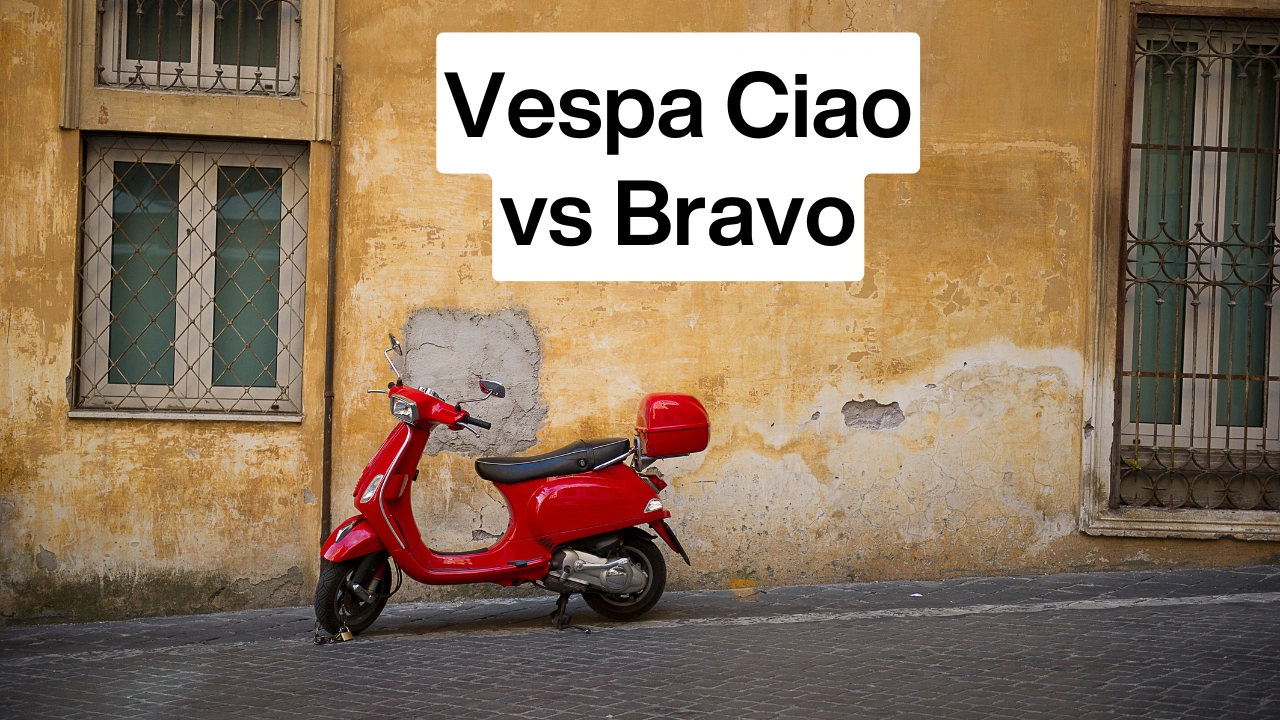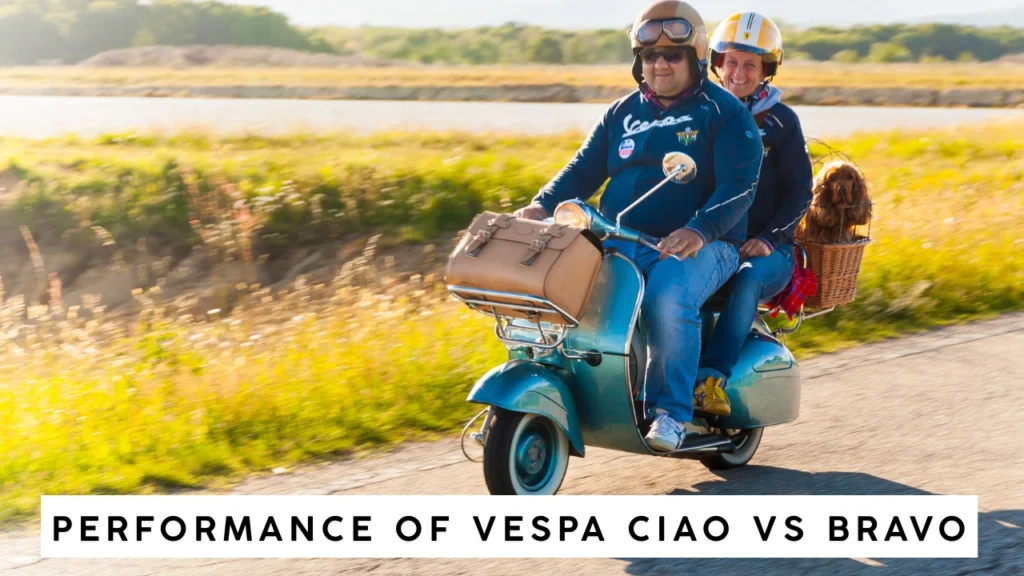Vespa Ciao vs Bravo: Classic Italian Mopeds Compared

In the world of mopeds, few names resonate with as much nostalgia and style as the Vespa Ciao and Vespa Bravo. Produced by the iconic Italian company Piaggio, both the Ciao and Bravo have become classic moped models appreciated by enthusiasts and casual riders alike. Vespa Ciao vs Bravo is a common comparison, as each moped brings unique features and advantages to the table. If you’re curious about which moped suits your needs, this guide dives into their distinct attributes, helping you understand the differences between these two beloved mopeds.
The Vespa Ciao: A Simple and Elegant Urban Cruiser
The Vespa Ciao was introduced in 1967 and quickly became popular for its simplicity and efficiency. With its lightweight frame, minimalist design, and easy handling, the Ciao is perfect for short urban commutes. The moped features a 49cc two-stroke engine that offers just enough power for city rides. Its focus on fuel efficiency and lightweight design has made it a favorite among young riders and those looking for a low-maintenance transportation option.
Despite its small engine, the Vespa Ciao can reach speeds of around 45-50 km/h (28-31 mph), making it a practical choice for city streets. The Ciao’s design is notably streamlined, with a rigid rear and a leading-link front suspension. This simplicity contributes to the moped’s affordability and ease of maintenance, as there are fewer parts to worry about. While its top speed may not be high, its fuel efficiency makes it an economical choice, especially for urban riders looking for a stylish and reliable mode of transportation.
The Vespa Bravo: A Sportier and Sturdier Option
Piaggio introduced the Vespa Bravo in the late 1970s, aiming to create a more robust and comfortable version of the Ciao. Like the Ciao, the Bravo also has a 49cc two-stroke engine, but its tuning offers slightly better acceleration and a higher top speed of about 60-65 km/h (37-40 mph). This increase in speed makes the Bravo a more appealing choice for riders who need a bit more power, especially for suburban or semi-rural commutes.
One of the main distinctions of the Vespa Bravo is its design, which includes telescopic front forks and rear shock absorbers. This suspension system offers a smoother and more comfortable ride, especially over uneven terrain. This added comfort and stability make the Bravo more versatile, especially for those who ride on various road conditions. The Bravo’s frame is also slightly sturdier, and it includes additional features like a more detailed instrument panel, providing riders with extra information at a glance.
Comparing Design and Performance: Vespa Ciao vs Bravo
When comparing Vespa Ciao vs Bravo, design and performance stand out as the key differentiators. The Ciao’s minimalist look contrasts with the Bravo’s sportier and more robust appearance. While the Ciao was designed for city commuting with a simple, lightweight frame, the Bravo was created for a more versatile range of uses, thanks to its stronger frame and improved suspension.

To give a clearer picture, here’s a table that summarizes the main differences between the two models:
| Feature | Vespa Ciao | Vespa Bravo |
|---|---|---|
| Engine | 49cc two-stroke | 49cc two-stroke |
| Top Speed | 45-50 km/h (28-31 mph) | 60-65 km/h (37-40 mph) |
| Suspension | Rigid rear, leading-link front | Telescopic front, rear shock |
| Design | Simple, lightweight | Sportier, sturdier |
| Fuel Efficiency | High | Moderate |
| Ideal Use | Urban commuting | Suburban or semi-rural commuting |
The Vespa Ciao vs Bravo comparison shows that the Bravo’s suspension and frame make it the better option for a smoother ride and a wider variety of road types. On the other hand, the Ciao’s simple design makes it ideal for those who value efficiency and style in a city setting.
Fuel Efficiency and Maintenance: Ciao’s Advantage
One of the biggest appeals of the Vespa Ciao is its fuel efficiency. Its lightweight build and smaller engine ensure that it uses less fuel than the Bravo, making it a more economical choice for frequent city commuters. Since the Ciao was designed to be a straightforward moped, it also has fewer parts that require maintenance. Owners of the Ciao can expect lower maintenance costs and easier repairs, which is ideal for those who want a low-cost, hassle-free ride.
While the Vespa Bravo offers a bit more speed and comfort, it comes with additional parts that require more frequent maintenance. The Bravo’s more complex suspension system, for example, will need attention over time to maintain a smooth ride. This increased need for maintenance can lead to higher costs in the long run, which is something to consider if budget is a concern.
Which Moped is Right for You?
Choosing between the Vespa Ciao vs Bravo depends largely on your riding needs and preferences. If you’re seeking a straightforward, fuel-efficient moped for city commuting, the Ciao is likely the better choice. Its lightweight frame and simple design make it easy to handle and economical to run. For urban riders, the Vespa Ciao’s blend of efficiency, affordability, and classic design is hard to beat.
On the other hand, if you’re looking for a moped that offers more power, a smoother ride, and the ability to handle slightly rougher terrain, the Bravo is an excellent option. Its improved suspension and slightly higher top speed provide a more comfortable ride for longer journeys or more variable road conditions. For suburban riders, the Bravo’s extra comfort and durability make it a more versatile choice.
Conclusion
In the Vespa Ciao vs Bravo comparison, each moped shines for different rider needs. The Ciao’s simple, fuel-efficient design is perfect for those prioritizing low maintenance and city rides, while its vintage appeal makes it a timeless classic. Meanwhile, the Bravo’s enhanced features and sturdier build offer more comfort and versatility, especially for riders venturing beyond urban streets. Both models are iconic in Piaggio’s history, celebrated for their unique blend of style, functionality, and the classic Vespa spirit that continues to captivate moped enthusiasts everywhere.
Frequently Asked Questions
Which model has a higher top speed, Ciao or Bravo?
The Bravo typically has a higher top speed of around 60-65 km/h (37-40 mph), compared to the Ciao’s 45-50 km/h (28-31 mph), due to its enhanced engine tuning.
Is the Vespa Ciao more fuel-efficient than the Bravo?
Yes, the Ciao is more fuel-efficient due to its lighter frame and simpler design, making it a better choice for frequent city use with lower fuel costs.
Which moped is easier to maintain, Ciao or Bravo?
The Ciao is generally easier to maintain as it has fewer parts and a simpler design, making it a more affordable and low-maintenance option.
Are both Ciao and Bravo suitable for beginners?
Yes, both models are suitable for beginners, although the Ciao’s lightweight and straightforward design may be slightly easier to handle for new riders.

